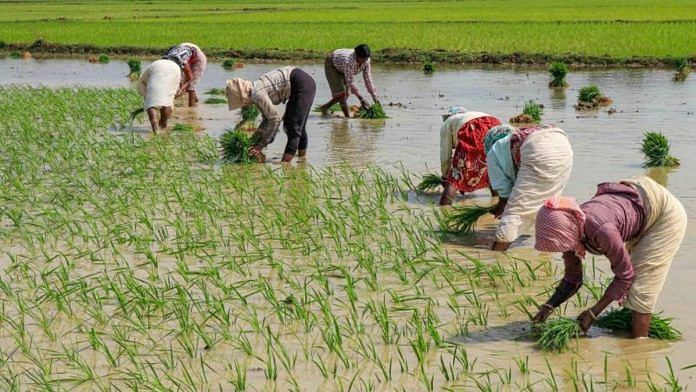New Delhi: After a severe heat wave in April-May singed India’s wheat crop, leading to a ban on exports, planting of rice, the main rain-fed crop in the ongoing kharif season, has been hit due to patchy rains in several states.
Major rice-growing states such as Uttar Pradesh, West Bengal, and Bihar have seen deficit rains so far during the ongoing monsoon season, while Assam has been affected by massive floods.
“Going by a conservative estimate and feedback from trade sources, about 15 million tonnes of rice production could be at risk,” said S. Chandrasekaran, a Delhi-based agriculture trade analyst.
“Due to deficit rains in eastern Indian states, farmers will likely opt for short-duration varieties where yields are lower, or shift to crops like moong (a variety of summer-grown pulses),” he added.
He further said that in Gujarat there has been a shift in acreage from paddy to cotton while excess rains in Telangana have damaged existing stock.
A hit to India’s rice output could lead to a major policy overhaul as it arrives on the back of a lower wheat harvest.
While the government estimated the wheat output at 106 million tonnes in 2022 — just about 3 per cent lower than last year — traders are pegging the harvest much lower, between 95 million tonnes and 100 million tonnes.
India is currently sitting on large public stocks of rice — over three times what it needs for food security and strategic reserve purposes. So far, the government has used the excess rice stock to replace some of the wheat supplied under food security schemes.
Also read: India’s protectionist moves spark fear that rice export may be curbed next after wheat, sugar
‘Don’t panic but don’t be smug’
T. Nanda Kumar, former secretary at the food and consumer affairs ministry, said “due to uneven rains, rice production could drop by about 10 million tonnes in the current season”.
“That’s not a reason to panic but India has to be cautious. You cannot be smug about it… the dip in production means less flexibility for the government,” he added.
“It may not be in a position to do open-market sales to cool rising prices. It may have to discontinue the free food scheme (Pradhan Mantri Garib Kalyan Anna Yojana), which is on till September, and may even be pushed to impose trade controls such as an export tax or a minimum export price.”
Unlike wheat, where India is a marginal player, it is a major rice exporter with a 40 per cent share in global rice trade.
In 2021-22, India exported 21 million tonnes of rice — about a sixth of its annual production of 127.9 million tonnes.
In the ongoing kharif crop season, India has set a target to produce 112 million tonnes of rice. The rest of the annual production comes from the winter rice planted in October-November.
Missing numbers
Data from the India Meteorological Department shows a high rainfall deficit in Uttar Pradesh (53 per cent lower than normal), West Bengal (26 per cent), and Bihar (45 per cent) between 1 June and 25 July. These three states contribute about a third to India’s annual rice production.
Assessment of the current situation in rice has been further mired by lack of data on planting.
Usually, the data is published every Friday, but, on 22 July, the agriculture ministry did not share data on the progress of rice-sowing. Data from a week earlier (released on 15 July) showed 17 per cent lower planting of rice, year-on-year.
Trade is, however, taking a cue from market prices that are on the rise. “Factoring in lower plantings, rice prices have climbed up from Rs 2,400 per quintal to Rs 2,600 in a matter of days,” said Rajesh Jain, a Delhi-based trader.
The demand, he added, is robust from neighbouring Bangladesh and from west African nations.
“Bucking the usual trend, Bangladesh has been purchasing large volumes of premium non-basmati rice from India over the past few months,” said B.V. Krishna Rao, president of the Rice Exporters Association.
“However, export prices are still lower than minimum support prices (MSP) announced by the government,” Rao added.
That metric is critical.
Higher export prices of wheat compared to MSP led to a shortfall in public purchases — as more farmers chose to sell to private traders and not to government agencies — eventually prompting the Union government to ban exports.
As of now, domestic prices are climbing. Wholesale prices of premium non-basmati rice increased to Rs 38 per kg from Rs 31 between end-May and end-July, said a rice trader who did not want to be named.
“If prices climb like this, wholesale prices will not be at the previous year’s levels when the new crop arrives in October,” he added.
Data from the department of consumer affairs shows that, as on 25 July, wholesale rice prices were 7.2 per cent higher year-on-year. Daily retail prices had climbed up the highest in Kolkata to Rs 40 per kg, an increase of 25 per cent over the previous year.
(Edited by Nida Fatima Siddiqui)
Also read: India ‘unlikely’ to revoke wheat export ban despite pressure. Now US to debate issue at UNSC



